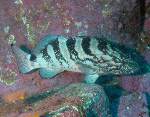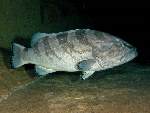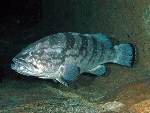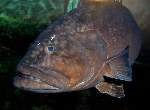Black Cod (Epinephelus daemelii)
Family: Serranidae
"The black cod is an iconic
species in NSW water however can prove to be very elusive to divers"
 The
Black Cod (Epinephelus daemelii) is a large reef dwelling cod/groper
species belonging to the family Serranidae. In Australia the black cod is also
known as black rockcod or saddled rock cod, and in New Zealand it is generally
referred to as spotted black grouper. Black cod are somewhat similar in appearance
to a number of other large Epinephelus species such as the bar cod (Epinephelus
ergastularius), Camouflage Cod (Epinephelus polyphekadion), the flowery
cod (Epinephelus fuscoguttatus) and the estuary cod (Epinephelus malabaricus),
and is sometimes confused with these and other related species. Epinephelus
species are commonly referred to as 'groupers' in the United States, and in
Australia they are known as 'cod' or 'groper'.
The
Black Cod (Epinephelus daemelii) is a large reef dwelling cod/groper
species belonging to the family Serranidae. In Australia the black cod is also
known as black rockcod or saddled rock cod, and in New Zealand it is generally
referred to as spotted black grouper. Black cod are somewhat similar in appearance
to a number of other large Epinephelus species such as the bar cod (Epinephelus
ergastularius), Camouflage Cod (Epinephelus polyphekadion), the flowery
cod (Epinephelus fuscoguttatus) and the estuary cod (Epinephelus malabaricus),
and is sometimes confused with these and other related species. Epinephelus
species are commonly referred to as 'groupers' in the United States, and in
Australia they are known as 'cod' or 'groper'.
 Black
cod are found along the entire New South Wales coast and are most common in
the waters off northern NSW. A few individuals have been recorded from southern
Queensland waters (e.g. off Flinders Reef) however they are considered to be
uncommon in the waters off Queensland. They are also common around Elizabeth
and Middleton Reefs, two offshore reefs in Commonwealth waters in the northern
Tasman Sea. Black cod are also found in the northern parts of New Zealand, and
are particularly common around the Kermadec Islands and Three Kings Islands,
though generally rare elsewhere in New Zealand.
Black
cod are found along the entire New South Wales coast and are most common in
the waters off northern NSW. A few individuals have been recorded from southern
Queensland waters (e.g. off Flinders Reef) however they are considered to be
uncommon in the waters off Queensland. They are also common around Elizabeth
and Middleton Reefs, two offshore reefs in Commonwealth waters in the northern
Tasman Sea. Black cod are also found in the northern parts of New Zealand, and
are particularly common around the Kermadec Islands and Three Kings Islands,
though generally rare elsewhere in New Zealand.
 The
colour pattern of black cod is highly variable, and can change quickly from
a uniform dark grey-black to a blotched or distinctively banded dark and light
pattern. Young black cod often have a number of distinct black markings that
tend to fade as the fish grows. These markings include a distinct black spot
or saddle just forward of the tail (the caudal peduncle), and five dark diagonal
sloping grey to black bars which generally fade towards the belly. The species
is usually uniformly dark in estuaries, and on coastal reefs with clearer waters
it generally has a banded pattern. It has been found that fish can change from
one extreme of colour to the other in just a few seconds, depending on their
'mood' and the colour of their surroundings.
The
colour pattern of black cod is highly variable, and can change quickly from
a uniform dark grey-black to a blotched or distinctively banded dark and light
pattern. Young black cod often have a number of distinct black markings that
tend to fade as the fish grows. These markings include a distinct black spot
or saddle just forward of the tail (the caudal peduncle), and five dark diagonal
sloping grey to black bars which generally fade towards the belly. The species
is usually uniformly dark in estuaries, and on coastal reefs with clearer waters
it generally has a banded pattern. It has been found that fish can change from
one extreme of colour to the other in just a few seconds, depending on their
'mood' and the colour of their surroundings.
 The
black cod, like most other Epinephelus species is a protogynous hermaphrodite,
which allows the species to change sex from female to male as it gets older.
Females change sex to become males at approximately 100 - 110cm length. Black
Cod can grow up to 2 metres in length but are more commonly seen around 1 metre
in size. Black cod at a size of 1 metre can be approximately 60 years old making
them a slow growing and long lived species.
The
black cod, like most other Epinephelus species is a protogynous hermaphrodite,
which allows the species to change sex from female to male as it gets older.
Females change sex to become males at approximately 100 - 110cm length. Black
Cod can grow up to 2 metres in length but are more commonly seen around 1 metre
in size. Black cod at a size of 1 metre can be approximately 60 years old making
them a slow growing and long lived species.
 Due
to overfishing in past decades, it is now unusual to find large black cod in
areas where they were once common. Historical evidence suggests that declines
in black cod numbers were already noticed in the vicinity of coastal cities
as far back as the early 20th century. It has been protected in NSW since 1983
and is listed as a vulnerable species under the NSW Fisheries Management Act.
If you do find a black cod approach the fish very slowly as they are extremely
shy and will flee to the safety of their cave or crevice. They are one of the
icon species of NSW and to find and photograph one is a considerable achievement!
Due
to overfishing in past decades, it is now unusual to find large black cod in
areas where they were once common. Historical evidence suggests that declines
in black cod numbers were already noticed in the vicinity of coastal cities
as far back as the early 20th century. It has been protected in NSW since 1983
and is listed as a vulnerable species under the NSW Fisheries Management Act.
If you do find a black cod approach the fish very slowly as they are extremely
shy and will flee to the safety of their cave or crevice. They are one of the
icon species of NSW and to find and photograph one is a considerable achievement!
Back
to Articles
 The
Black Cod (Epinephelus daemelii) is a large reef dwelling cod/groper
species belonging to the family Serranidae. In Australia the black cod is also
known as black rockcod or saddled rock cod, and in New Zealand it is generally
referred to as spotted black grouper. Black cod are somewhat similar in appearance
to a number of other large Epinephelus species such as the bar cod (Epinephelus
ergastularius), Camouflage Cod (Epinephelus polyphekadion), the flowery
cod (Epinephelus fuscoguttatus) and the estuary cod (Epinephelus malabaricus),
and is sometimes confused with these and other related species. Epinephelus
species are commonly referred to as 'groupers' in the United States, and in
Australia they are known as 'cod' or 'groper'.
The
Black Cod (Epinephelus daemelii) is a large reef dwelling cod/groper
species belonging to the family Serranidae. In Australia the black cod is also
known as black rockcod or saddled rock cod, and in New Zealand it is generally
referred to as spotted black grouper. Black cod are somewhat similar in appearance
to a number of other large Epinephelus species such as the bar cod (Epinephelus
ergastularius), Camouflage Cod (Epinephelus polyphekadion), the flowery
cod (Epinephelus fuscoguttatus) and the estuary cod (Epinephelus malabaricus),
and is sometimes confused with these and other related species. Epinephelus
species are commonly referred to as 'groupers' in the United States, and in
Australia they are known as 'cod' or 'groper'.


